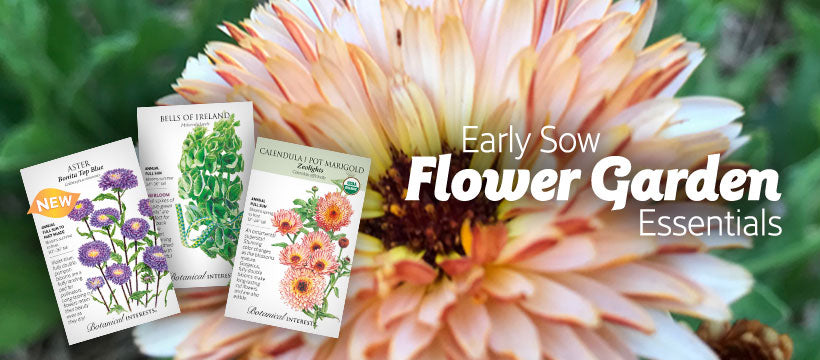Small on space but big on gardening? A lot can happen in a small space, and containers are a great way to transform a small space into a garden oasis. With some creativity and the right varieties, a small space can still offer a big yield.
Tips to make the most of your space

Grow up!
Growing vertical is an efficient use of space for vines like tomatoes, beans, squash, melons, cucumbers, and peas. Using trellises, cages, and fencing also saves your knees, increases airflow to plants, which reduces the risk of fungal diseases, and puts harvest within arm's reach. See our DIY Tomato Supports blog for a low-cost, easy way to trellis tomatoes, cucumbers, winter squash, flowering vines--really anything that will climb.
Smart spacing
Sow for two harvests at once. For crops that offer a one-time harvest like carrots or radishes, sow and thin to half the final suggested spacing. Harvest every other plant when they are half grown for baby carrots and beets. Sow radishes between rows of slower maturing crops like carrots. Quick to sprout radishes not only mark where you've planted and where you need to water, but will be harvested before the other crop is large enough to feel crowded. Also, planting in a staggered triangular pattern is more space efficient than rows or squares.
Start indoors
Many crops can be started by seed indoors and transplanted out shortly after. This can save a couple of months or more time in the garden bed, leaving room for something else to mature.
How to Grow in Containers
Location
When choosing varieties to sow in your pots, be sure to take sun exposure into consideration. Full sun means plants will perform best with 6 or more hours of sunlight. Most vegetables are going to want full sun, but many leafy vegetables and herbs, like basil, lettuce, and kale, adapt to shadier situations because of their big leaves. Also, consider how the location may impact the container and plants' temperature. For instance, a south-facing brick wall can really heat up in summer possibly making a heat-loving crop like melons or peppers a better choice for that location than lettuce, which thrives in cool weather.
Soil
Your container's potting soil (medium) is really important. If you're having a hard time choosing, pick one that is labeled for containers. It will hold the right amount of water, nutrients, and air to ensure the healthiest possible plants. Some potting soil comes with compost or slow-release fertilizer incorporated right into it; consider this when evaluating cost.

Container
Larger containers are easier to care for. They require less frequent watering and are more insulated from temperature fluctuations. At the minimum, be sure to plan your container according to the mature size of plants you want to grow in it. A bit of crowding can work, but don't overdo it. Overcrowding can cause stress and competition. Stress can be an invitation to pest and diseases.
Want to use a really big container but worry about being able to move it or about the cost of all the soil to fill it? You can place a turned over plastic pot or some recycled packing peanuts in the bottom to displace some of the soil. You'll save on potting soil and water, and your container will weigh less, too. Clay pots tend to dry out faster and are heavier than resin or plastic pots. Dark colored pots will collect more heat which can cause the potting soil to dry more quickly, so just keep that in mind when choosing your color palette.
Water and Fertilizer
Keep in mind, containers that are really full, very small, or in sunny and windy places will need water more often, maybe twice a day! Watering in the morning or evening is ideal. Plants that have consistent moisture, instead of periods of drought, will stay pretty healthy, and productive longer. Container plants need regular feeding. If your potting soil doesn't contain fertilizer, add a slow-release fertilizer, or feed regularly with a water-soluble fertilizer.
Even if your potting soil does contain fertilizer, it is a good idea to fertilize after a couple months of use because nutrients are used up by plants and also leach out as you water. For best results, follow the application amount and schedule recommended by the fertilizer manufacturer. Read more about choosing fertilizer in our article, How do I Know Which Fertilizer to Use?.
Great container varieties
Our Container Vegetable Collection is an easy choice for container growing. Don't rule out crops you thought were too big for containers. A larger container (4 gallons or more) can grow a tomato, a couple of peppers, a summer squash or even bush-type winter squashes (acorn types) or a cucumber (try 'Spacemaster') just fine! The same goes for root crops like beets and carrots. Use a deeper pot (at least 12") for these delicious roots and choose a small variety like 'Tonda di Parigi' carrots, or harvest beets at a smaller stage. Add alyssum, too, for color and fragrance while attracting beneficial insects and pollinators. You can also grow Swiss chard or 'Red Giant' mustard to add beautiful, edible color and texture to decorative container plantings.


